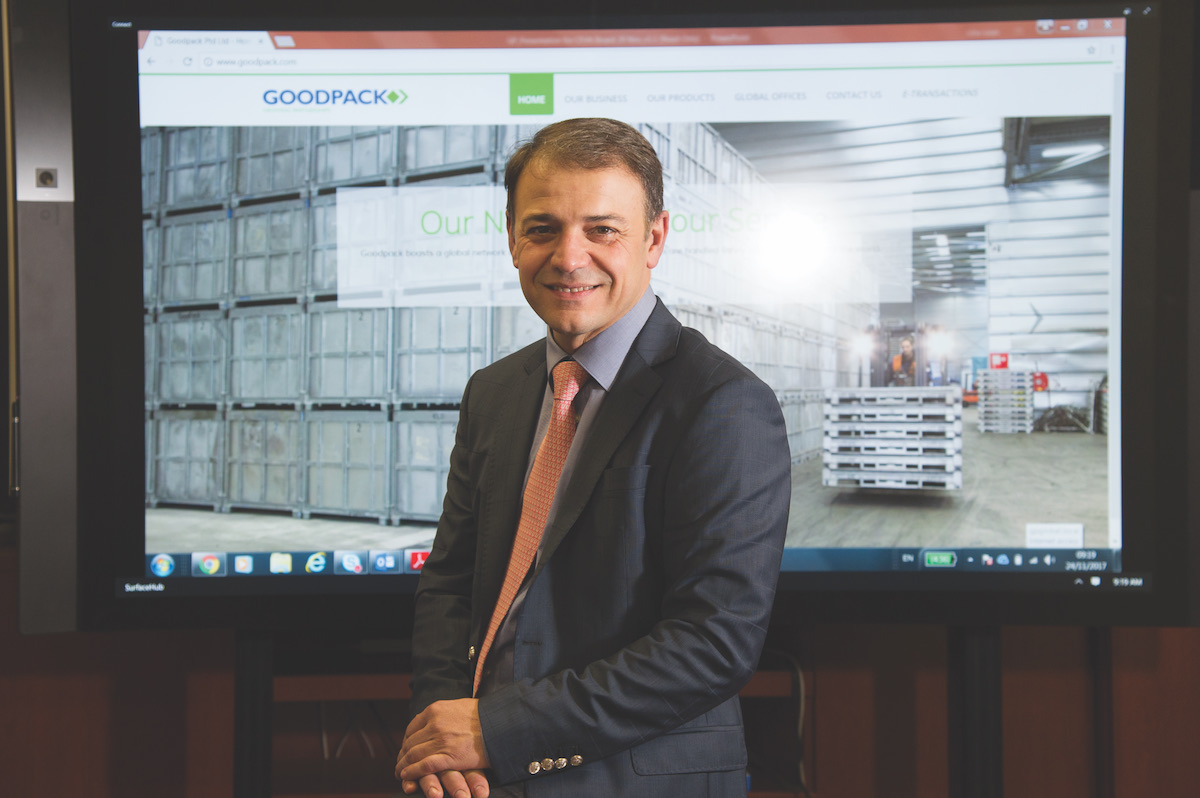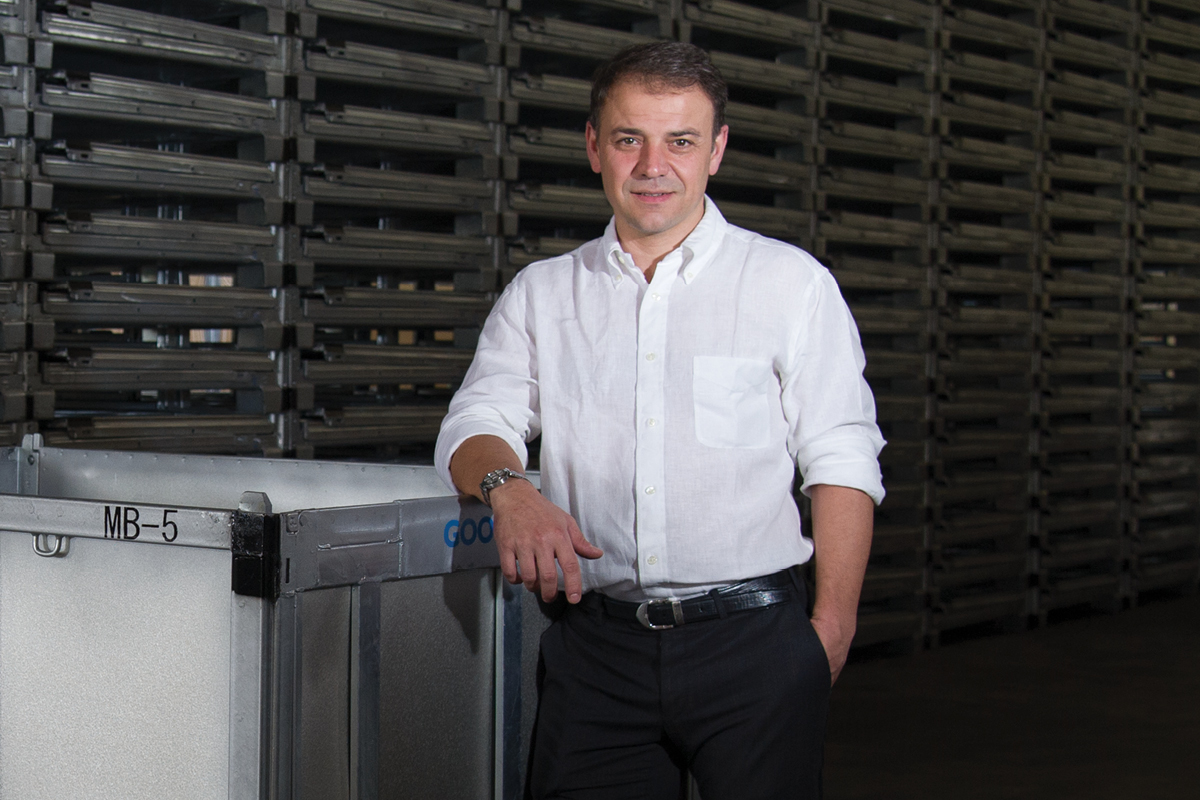Based in Singapore, Goodpack has offices throughout Asia–Pacific and EMEA, as well as North America and Latin America. Having pioneered a shipping and storage solution that is both economical and environmentally friendly, the business continues to innovate. We talk to the CEO Eric Gregoire
about his vision for the company.
The CEO Magazine: When you first took on the role of Group CEO at Goodpack, what opportunities did you see for improving and growing the business?
Eric: When I joined, the company had grown from owning zero to 3.5 million intermediate bulk containers in 35 years. These are multi-modal, reusable metal containers that provide packaging, transport and storage for a range of core industries globally. Goodpack basically started an industry with more than 20 offices scattered over many countries.
But the remarkable thing for me was the network of pick-ups: people could pick up the containers at more than 5,000 collection points all over the world. When I joined, I realised that Goodpack is the only supply chain partner that is truly end-to-end – from a village in Indonesia, to a modern power plant in Europe, to a guava plantation in Honduras, to an organic fruit juice producer in New York. It’s a very long and complex global supply chain, and Goodpack is the only constant throughout.
In addition to safely storing and transporting our customers’ products in these containers, we also acquire various bits of information through continuous RFID [radio-frequency identification] monitoring. This monitoring can save millions of dollars by ensuring safer stocks along the supply chain that could otherwise be wasted.
When you think of a Goodpack container not merely as a way to store and transport goods but also as a way of acquiring information, you can create an end-to-end tracking solution that eliminates useless working capital, and that’s very exciting.
What are the main ingredients of a good management strategy?
A good strategy needs to be developed according to three principles. One is that the strategy needs to be grounded in solving a customer issue – it needs to be something they will pay for. My team and I try to sanity-check ourselves. We say, ‘We have just spent two hours in this meeting. If customers were sitting in the corner, would they be willing to pay for this meeting?’
The second principle is about being deeply grounded in reality. You have to face reality – with your business, your customers, and the peer group you’re operating in. And the third is that it has to be creating a sustainable competitive advantage.
From there, there are four crucial steps to developing a strategy. First, you’ve got to decide on the game you’re playing. To use a sporting analogy, ‘Are you playing soccer, or rugby, or tennis?’ In business, we call this a mission statement.
Then, when you’ve decided which game you are playing, you’ve got to determine if you are winning. In sport, you can just look at the scoreboard to find out if you’re winning or not. In business, it’s a bit more complicated.
You need to set key performance indicators, but those KPIs need to be industry-backed and benchmarkable so you can know if you are winning. Then you have to work out what kind of team you need.
For example, with soccer you need to think about how you set the field, and whether you play in four–three–four or four–four–three.
There’s a lot of groundwork that needs to be done prior to developing a strategy.
Once you’ve got that, you need to decide, ‘How do we win?’ And that’s the strategy, basically. There’s a lot of groundwork that needs to be done prior to developing a strategy.
What is your approach to keeping the team united when you have so many offices around the world?
For me, the company is like a community that cuts across geographies and cultures, and if you look at what it takes to make a community harmonious and growing, it’s trust. So, the whole thing is based on how we build trust within a group, and we do that by creating a culture. I strongly believe that creating a company culture is the most important job and the most lasting legacy of a CEO.
I spend a lot of time trying to exemplify the culture and build trust.
Culture is about the values we share and the way we do things. I spend a lot of time trying to exemplify the culture and build trust when I’m with the customer and meeting teams. I feel that the culture that we build will eventually turn into trust, and trust is what makes people work together.
What has been the biggest challenge at Goodpack and how did you overcome it?
The biggest challenge is getting the buy-in for a change agenda. Particularly at Goodpack, where we’ve got such a great success story, people ask, ‘Well why would you want to change what works?’

Goodpack is backed by private equity. Many people who have worked in companies partnered with private equity can be nervous because some private equity firms can be seen as short-term oriented. As a CEO, are you seen as trying to balance the long-term needs of the company with the short-term wants of shareholders? Thankfully, with the company we partner with, that’s not the case.
KKR takes a very long-term view of value creation, which is very well aligned with Goodpack’s objectives. The challenge for us, therefore, was to blend the past with the future. We can’t just stay the same, we need to grow – so it’s finding that balance when creating a vision for a change agenda.
The way I approach it is by asking people: ‘What’s in it for you?’ This could be a supplier, a consumer, an employee, or a shareholder – I always try to explain what’s in it for them to create a momentum towards a common objective. I think that everybody has a personal agenda in addition to a professional agenda, and it is very powerful when both those agendas are aligned to a single big objective.
To understand what’s in it for them, I’ve tried to practise active listening and humility for years and years. And because you can’t understand people without listening to them, you need to be accessible. As a CEO, unless you are humble, when you ask someone a question, you will only ever get the socially acceptable answer, not necessarily the real answer. I have two ears and one mouth and it’s taken a lot of practice to bring the ratio of using them closer to the natural proportion. It’s one of life’s lessons for CEOs, and I hope to be better today than yesterday, and to be even better tomorrow.
What are your goals for the next three to five years?
For the next three to five years, our goal is to realise the potential of Goodpack as the leading supply chain solutions provider for customers. We want to be seen as a true partner instead of just a supplier of packaging material. We are using digital technology to track the containers and increase efficiency.
We are also looking to break into the Chinese market, and I think it will happen because they are increasingly looking at the environmental impact and related issues. Ours is a zero-waste solution, so the containers are very environmentally sound.
You recently won an award for supply chain innovation at the Gulfood Manufacturing Industry Excellence Awards. Can you tell us about that?
It was amazing to be honoured with that award, especially when you consider that the other winner in the supply chain category was the Ford Motor Company. Goodpack containers, in contrast to other containers, are made of steel. This means they are suited to cold storage and there is total discharge
of the product afterwards. There is no wastage. And when you add the RFID tracking, it becomes a solution that saves a lot of money for our customers.
When you look back over your career, what are you most proud of?
I must admit that while I’ve had my successes, I’ve also had my share of disappointments. But what has touched my heart the most is a story from 2010. I took over the leadership of a chemical operation that had been underinvested in for many years. The equipment was old, you had rust in the plant, dust everywhere; you’d never see a customer visiting the factory, and the staff were disillusioned with the corporate culture.
The challenge was turning this around in 18 months with the operations teams. I gave them the challenge to make and execute changes, and then we held an open day for employees’ families, our customers and the community. On that day I could see the renewed pride in the company.
Seeing the team with their mothers and fathers and their friends was priceless. After that, as the next family day approached, I could see people looking at the things they wanted to improve in order to show them to the community and their families. That was extremely heart-warming.
What do you love most about your job?
I love to see people win, and I truly believe that nothing breeds success like success. If I can help someone to achieve something, that really makes my day.



